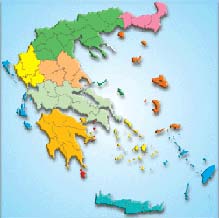
Please click on the map,
the region you want to visit |
|
|
|
|
| |
|
 |
Mani. Lakonian and Messinian Mani |
|
Mani, a place of stone and sun, frugal but vastly charming, with mountain landscapes over bays that fighting stubbornly against the winds, with small villages and castles of timeless folk architecture, with countless Byzantine churches and caves that are cradles of the existence and the culture.
| In Mani there are 98 traditional villages
from the 118 of Peloponnese. |
Tough and frugal people, with deep roots in customs and traditions, pride and hospitable.
Mani is imperious and insubordinate, historical and traditional, unique in every step for the lucky visitor who wonders how the prickly and the olive trees find soil in the arid territory and give, however, fabulous oil.
Mani descends from Taygetos, west at the coasts of the Messinian Gulf, east at the creek of the Lakonian Gulf, south to the great peninsula, the Western "foot" of Lakonia. |

 |
Taygetos Mount lowers between Gythio and Areopolis and rises again, with the name Sangias, until to the southern tip of the peninsula, the Cape Tenaro, and creates the South Mani, dividing it in both, East and West Mani.
In East Mani, south of Gythio, the slopes of the mount fall steeply to Laconian Gulf. In West Mani, south of Areopolis, the Mesa Mani, the mount creates a flat, low platform with limestone composition, that drains the water in the Messinian Gulf, mainly through underground karst formations, and arrives dry and barren to the sea. Due to the erosion, the west coast is full of caves. Among them, the famous caves of Diros - Vlychada, Katafigi and Alepotripa.
• The name Mani is said to have originated from the Latin word Manus (hand), from sailors that passed the Cape Tenaro and had likened the plan of the shore to Brazzo di Maina.
• Others people argue that the name was given by the sailors again, who were passing through the area and did mynah the sails, because of the strong winds.
• Another version states that the Romans were regularly saying the words In Manis, because here was the gate to Hades where the souls come (Manes).
• The prevailing view is this that refers to the construction of the castle of Mainis by Mainis (architect).
• In a final version, it is said to have originated from the father of the gods "Mani", who is the father of Saturn and grandfather of Zeus, and is mentioned in Theogonia of Apollodoros as "Manis, the second name of the god Uranus". |
Previously, Mani, administrative, constitutes a single region including the Messinian Mani and Laconian Mani, when, by law, the northern part of West Mani (Exo Mani), which belonged to the province of Itilo, was annexed to the province of Kalamon of Messinia.
Wherever went those who left, they have held, like the ones who stayed, habits and traditions. Those traditions that accompany today's visitors of Mani are the towers, the churches and the castles at the coastal settlements in the depth of bays and the derelict complexes of houses at the mountains of the interior. Mani, the place of stone and sun, frugal but infinitely charming.
| For a long time, the name "Mani" was synonymous with freedom, as Mani always remained free from invaders and kept intact the customs and traditions during its long history. |
|




|
 |
Accommodation proposals, entertainment and shopping in Mani |
|
|
|